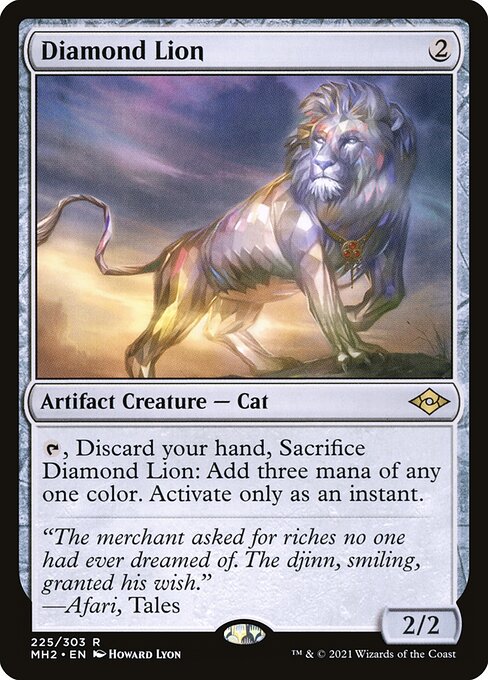
Image courtesy of Scryfall.com
Typography and Tactics: Diamond Lion’s Oracle Text, Layout, and the Quiet Power of Colorless Color
There’s something charming about a card that looks unassuming at first glance but rewards patient, creative deck building. Diamond Lion is the rare artifact creature from Modern Horizons 2 that reads like a practical joke—until you realize it’s a serious engine in disguise. At a modest mana cost of {2}, this 2/2 cat-shaped block of potential sits in your mana pool with a typography that telegraphs both simplicity and possibility. The card’s oracle text is short, almost minimalist: T, Discard your hand, Sacrifice this creature: Add three mana of any one color. Activate only as an instant. In a single line, the design communicates constraint, risk, and a powerful payoff—three mana of any color, instantly, at instant speed, but only after you’ve emptied your hand and sacrificed the Lion.
From a typography and layout perspective, Diamond Lion leans into the Modern Horizons 2 normal frame with a clean, legible hierarchy. The name sits at the top in a bold, high-contrast typeface, followed by the mana cost in the upper-right corner—an anchor for players parsing the card at a glance. The artifact creature — cat type line sits just below the art, letting you immediately latch onto its flavor: a creature that acts as a tool, not a charge attacker. The oracle text block is compact but complete, with the punctuation and line breaks designed for readability during a heated game state. The punchline arrives in the flavor text—“The merchant asked for riches no one had ever dreamed of. The djinn, smiling, granted his wish.”—which sits beneath the rules text, inviting you to imagine Afari’s tales alongside your play chair. The typography, then, does more than convey mechanics—it nods to lore and pacing, letting you savor a moment of storytelling between taps and sacrifices.
“The merchant asked for riches no one had ever dreamed of. The djinn, smiling, granted his wish.” —Afari, Tales
In terms of color, Diamond Lion is a rare beast that produces mana of any color without belonging to a color identity itself. Its mana production line—Add three mana of any one color—is where the typography and layout meet design pragmatism. The card announces a command: choose a color and push three mana into your tempo. The constraint that this can only be activated as an instant adds a layer of timing to the layout’s rhythm; you’re not just calculating resources—you’re calculating opportunity. The result is a card that reads like a blueprint for decision: you can turn a blank hand into a dense mana spike if you’re careful, but you must sacrifice the Lion to do so. The art, the rarity mark, and the frame all work in concert to communicate that the payoff is big, risky, and wonderfully cinematic. 🧙♂️
Layout as Storytelling: How the Card Speaks to New and Veteran Players
Diamond Lion’s layout in MH2—the Modern Horizons 2 set—reflects a design philosophy: make functional typography central to play experience. The mana cost is immediate, the creature type clear, and the activated ability’s cost-and-effect structure instantly communicates risk and reward. The absence of color in the mana cost is not a flaw but a deliberate signal that this is a colorless engine with colored possibilities. The “three mana of any one color” payoff invites color fixing in decks that want to pivot quickly, while preserving a cadence that can keep pace with multi-color strategies when built around the right support spells and draw engines. The art and flavor text reinforce the idea of a high-stakes trade—wealth for power, risk for reward. It’s a small snapshot of the Magic multiverse in a single card: a tigerish cat of industry and mystique consorting with djinn lore. 🔥💎⚔️
From a collector’s perspective, the card sits in an interesting space. It’s a rare card from a set type: draft_innovation, with both foil and nonfoil finishes and a strong on-paper utility that translates well to Commander and casual formats. The frame and border choices—black border, 2015 frame—signal a style that appeals to players who enjoy a blend of classic readability with modern conveniences. The art by Howard Lyon is a centerpiece that invites a closer look during sleeved matches, making it the kind of card that earns a second glance on the table between matchups. 🎨
While Diamond Lion doesn’t color a pure five-color deck by itself, its strategic value is undeniable. In a format where your hand might be thin or your mana base needs a reset, sacrificing the Lion to generate a tidal wave of mana can unlock explosions of play—think of it as a financial instrument for a turn or two, traded for immediate liquidity in the form of three mana of a chosen color. It’s not just about raw power; it’s about the timing and tempo you can weave into the game plan. The card’s design rewards careful sequencing—hold a hand that can be discarded to the Lion during a pivotal moment, then use that three-color surge to cast a game-changing spell or power out a win condition. 🧙♂️🎲
In the Wild: Practical Deck Ideas and Thematic Fits
For players who love a little risk with their reward, Diamond Lion shines in decks that lean on draw-discard dynamics and instant-speed plays. Pair it with wheel effects or hand-refresh engines to ensure you have something to discard while maximizing the mana payoff when it resolves. In casual and multiplayer settings, the card encourages bold, tempo-rich plays that quickly convert a glass-half-empty situation into a spark of color-splashed acceleration. It’s the kind of card that makes you grin when you untap and announce, “Three mana of your color, please,” right before closing out a strategic line of play. 🧙♂️🔥
Neon Phone Case with Card Holder Glossy Matte Polycarbonate MagSafe